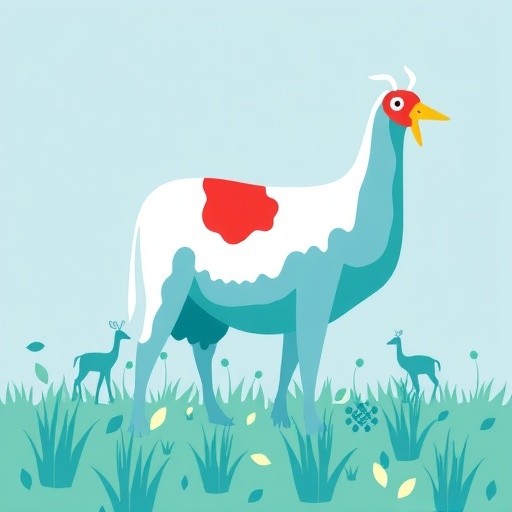Current scientific evidence points to contaminated feed and water sources as significant vectors for primary infection in cows, likely resulting from environmental exposure to virus-shedding wild birds. Additionally, aerosolized viral particles and fomites—contaminated surfaces or equipment—are hypothesized to facilitate rapid and extensive dissemination within and across farms. These factors complicate traditional containment methods, as the virus exploits both direct and indirect contact routes inherent to dairy farm ecosystems.
.adsslot_KJkxT0hqEt{width:728px !important;height:90px !important;}
@media(max-width:1199px){ .adsslot_KJkxT0hqEt{width:468px !important;height:60px !important;}
}
@media(max-width:767px){ .adsslot_KJkxT0hqEt{width:320px !important;height:50px !important;}
}
ADVERTISEMENT
A particularly concerning revelation involves the virus’s affinity for sialic acid receptors, which are abundant in the udders and respiratory tracts of cattle. This biological specificity suggests that respiratory aerosols and contact with infected milk contribute to escalating intra-herd transmission, though many details of these mechanisms are still being elucidated. Experimental models and field research provide some insight, yet substantial gaps in understanding cow-to-cow viral kinetics persist, underscoring the urgency for intensified research and surveillance.
The review emphasizes that dairy farms function as complex ecosystems, composed not solely of cattle but a dynamic interplay of multiple species—including birds, rodents, insects, and humans—and varied environmental matrices such as water sources, bedding, housing, and equipment. This interconnectedness amplifies the challenge of controlling H5N1, necessitating coordinated interventions that transcend traditional siloed approaches. Collaboration among producers, veterinarians, researchers, and governmental agencies is thus presented as indispensable for effective management and eventual eradication.
Beyond animal health, the impact on human populations intimately connected to the dairy industry demands equal attention. Documented cases of H5N1 infection in farmworkers have predominantly manifested as mild conjunctivitis or flu-like symptoms. Nevertheless, these infections underscore zoonotic potential and highlight occupational hazards inherent in close contact with infected animals. The psychosocial toll on workers, veterinarians, and producers is equally profound, as prolonged outbreak conditions exacerbate mental health challenges and strain livelihoods.
Moreover, the repercussions extend to the poultry sector, where spillback infections have necessitated mass depopulation efforts exceeding 28 million commercial birds. Transmission pathways between cattle and poultry are not yet fully delineated, representing a critical frontier for research. Understanding these cross-species dynamics is paramount to developing targeted biosecurity protocols and mitigating economic losses within interconnected agricultural systems.
The possibility of H5N1 evolving into a strain capable of sustained human-to-human transmission remains uncertain but concerning. Epidemiologists caution that continuing failure to control viral spread in animal reservoirs increases the risk of mutation or reassortment events that could precipitate a pandemic scenario. This scenario emphasizes the need for proactive public health measures grounded in rigorous scientific evidence and proactive policy measures.
Recommendations provided in the review advocate for a multi-pronged strategy that includes the declaration of H5N1 as a public health emergency to mobilize resources and mandate comprehensive testing across cattle populations. Free and widespread diagnostic surveillance, combined with enhanced worker health monitoring, livestock vaccination programs, and indemnity compensation for affected farmers, are proposed as critical components in this comprehensive framework.
Finally, the development and equitable distribution of H5N1 vaccines targeting at-risk populations, including farmworkers and veterinarians, represent a vital arm of outbreak control. Coordinated vaccine rollout plans are necessary to ensure timely protection and to curb zoonotic transmission risks. Sustained commitment across sectors will be indispensable to actualize these scientific recommendations in the field.
The findings presented in this invited review constitute a seminal contribution to the understanding of a novel and rapidly evolving one health crisis. It calls for renewed vigilance, interdisciplinary cooperation, and the harnessing of scientific innovation to safeguard both agricultural productivity and public health. As Dr. Paul Kononoff, editor-in-chief of the Journal of Dairy Science, aptly noted, “The health of our dairy herds, farm workers, and the broader community are intimately interconnected, and only through a unified One Health perspective can we hope to overcome the challenges posed by this devastating H5N1 outbreak.”
Subject of Research: Animals
Article Title: Invited review: The One Health challenges and opportunities of the H5N1 outbreak in dairy cattle in the United States
News Publication Date: August 14, 2025
Web References:
https://doi.org/10.3168/jds.2024-26222
https://www.journalofdairyscience.org/
https://www.cdc.gov/one-health/about/index.html
https://www.rand.org/pubs/commentary/2024/12/getting-ahead-of-h5n1-declare-a-public-health-emergency.html
References: DOI: 10.3168/jds.2024-26222
Image Credits: Chloe Stenkamp-Strahm
Keywords: H5N1, avian influenza, dairy cattle, One Health, zoonosis, viral transmission, biosecurity, outbreak control, animal health, human health, pandemic risk, vaccine development
Tags: avian influenza transmission dynamicsbiosecurity measures for dairy farmsbird flu outbreak in dairy cattlecontaminated feed and water sourcesdairy community response to avian influenzadisease surveillance in livestockeconomic impact of animal disease outbreaksH5N1 virus impact on agricultureinterdisciplinary health strategiesOne Health approach in agricultureveterinary health and animal welfarevulnerabilities in animal health systems





